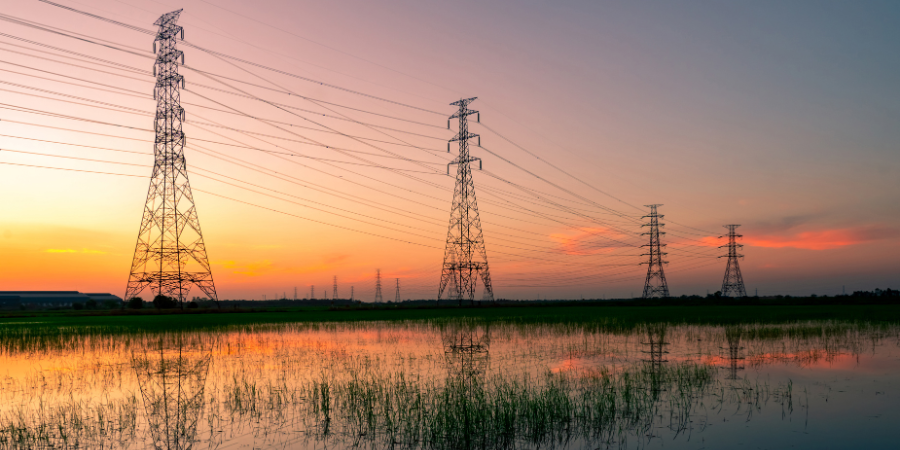Financial Transmission Rights (FTRs) are essential financial instruments in both retail and wholesale electricity markets. These instruments are utilized by retail electricity suppliers, power utility companies, and energy traders to achieve different outcomes. This article aims to provide a clear, informative overview of FTRs, their usage in power markets, how FTRs fit into the electric grid, and their significance in relation to retail energy contracts.
What Are Financial Transmission Rights, or FTRs?
In simple terms, FTRs are energy contracts between two parties that allow them to exchange the price difference between two electricity nodes, or locational points on the electric grid. Prices for electricity at different locations change because of congestion on the electrical transmission lines.
Congestion is often explained using taxi cab meters in New York City. When it’s rush hour, it costs more money to travel 30 blocks in Manhattan compared to times with lesser traffic. In the electric markets, when there is little to no congestion, the price difference between two points is typically zero. However, when there is lots of congestion on a particular transmission line, it drives up the costs of power on that line and creates a price differential between locations on that line. In an attempt to hedge against this price risk, or to turn a profit, energy companies and traders utilize FTR contracts.
The FTR contract is an agreement to receive or pay the difference between two pricing nodes in an electricity grid, multiplied by the amount of the contract, in Megawatts (MW). In the contract terms, these two locations are referred to as the Sink and the Source. FTRs can be acquired by retail energy suppliers, service companies, or traders in three ways:
- Annual FTR Auctions
- Monthly FTR Auction
- Secondary Markets
Although all FTR contracts work in a similar fashion, they are known by various names on different electricity grids, or Independent System Operators. On the CAISO in California and ERCOT in Texas, they are known as Congestion Revenue Rights (CRRs). In the NYISO in New York State, they are referred to as Transmission Congestion Contracts (TCCs). And in PJM, ISO-NE, and MISO, they are known as Financial Transmission Rights (FTRs).
Let’s explore further about how FTRs, CRRs, and TCCs are utilized in order to stabilize electricity costs for consumers, or in the hopes of turning a profit.
How Are FTRs Used In The Power Markets?
FTRs are unique as they are used by both energy hedgers and speculators, and are obtained through Independent System Operators/Regional Transmission Organizations (ISO/RTOs). And, unlike other energy financial contracts, FTRs are not traded on traditional exchanges like NYMEX, ICE, or CME. Let’s dig into how these financial contracts are utilized in day-to-day business.
Hedging Using FTRs
Energy market participants with physical power delivery obligations often use CRR/FTR/TCCs to hedge against fluctuations in electricity congestion prices. When used as a hedge, these instruments lock in the congestion price, mitigating financial risk associated with power delivery on particular power transmission lines. Let’s look at an example of how FTRs can be used to hedge costs for an electricity supplier:
Hedge Example
Let’s assume that Retail Supplier A has an electricity Customer B located in a certain zone on the PJM electric grid. Retail Supplier A’s costs to supply electricity to Customer B are as follows:
(Energy Cost) + (Congestion Cost) + (Loss Component) x (MWhs)
For example purposes only, let’s assume that Congestion and Loss Components are $0 and Energy Costs are $50/MWh for every hour in the billing period. So, Retail Supplier A’s costs to supply Customer B are:
($50/MWh) + ($0/MWh) + ($0/MWh) x (Total MWhs) = $50/MWh
Now, let’s assume that a transmission line near Customer B’s location goes down in the middle of the month, causing Congestion Costs on the lines supplying Customer B’s location to spike to $30/MWh. Now, supplier A’s costs are now:
($50/MWh) + ($30/MWh) + ($0/MWh) x (Total MWhs) = $80/MWh
If Supplier A did not utilize an FTR instrument to properly hedge congestion, their new costs to supply Customer B are $80/MWh. This could equate to a loss for the supplier depending on the price of the retail electricity contract.
In order to hedge against potential spikes in Congestion Costs, Supplier A could have purchased an FTR. When Congestion Costs rose to $30/MWh, Supplier A would have received that revenue from the grid operator, offsetting their losses and equating their net costs to the original $50/MWh.
Trading Speculation Example
Using the same example as above, a trader or speculator could also purchase the same FTR contract if they had a view that the price difference between the Sink and Source would increase. In order to purchase the FTR, the trader would submit a bid in an auction for the amount they are willing to pay for a certain pathway on a transmission line (SOURCE to SINK). The trader could also acquire the FTR in the secondary market.
These contracts are purchased in lots and have associated values for specific periods (e.g. 10 MW – February 2024 – On Peak 7am to 11pm). The value of this contract for the trader is equal to:
[(SINK PRICE) – (SOURCE PRICE)] x (On Peak Hours) x (Total MW)
For a particular hour, let’s assume the SINK PRICE and the SOURCE PRICE are both $50/MWh when the trader purchases the FTR. Then, due to congestion, the SINK PRICE rises to $80/MWh. Here is the trader’s profit on the FTR for that single hour:
[($80/MWh) – ($50/MWh)] x (1 hr) x (10 MW) = $300
Since energy traders and speculators do not have consumer offtakers to hedge their risk, they are also on the hook when prices turn against them. In fact, there have been several trading organizations and FTR hedge funds that have filed for bankruptcy due to the volatility in these energy markets.
FTR Application In The Retail Energy Markets
The use of FTRs is not a long-standing practice, gaining momentum in the last 15-20 years among retail energy suppliers. These instruments became significant due to the non-storability of electricity, the necessity to maintain a grid frequency, and the onset of energy deregulation throughout the United States. Over time, various electric grid operators introduced FTR contracts that allow retail energy suppliers to better control their wholesale energy market supply costs.
As an end user, you are most likely not aware of any FTR trading or hedging behind the scenes, yet these contracts play a critical role to ensure that you get a safe and stable supply of electricity to your facility. In fact, depending on the terms of your retail energy contract, your energy supplier is most likely utilizing FTRs in an effort to hedge against volatile energy prices.
Want To Learn More About The Energy Markets?
Our team of retail energy market professionals has over 100 years of combined experience pricing energy loads and hedging costs for our commercial and industrial customers. Contact us today to explore more about Financial Transmission Rights, retail energy supply products, and strategies to lower your total cost of energy supply.



